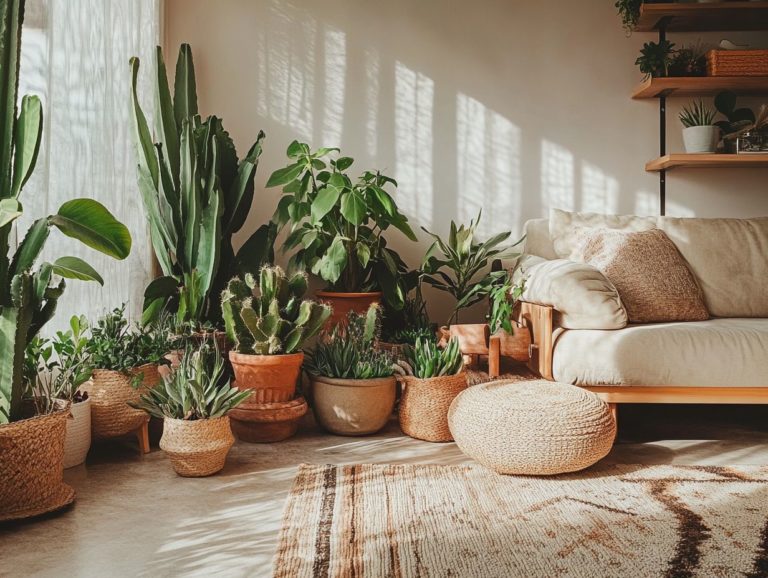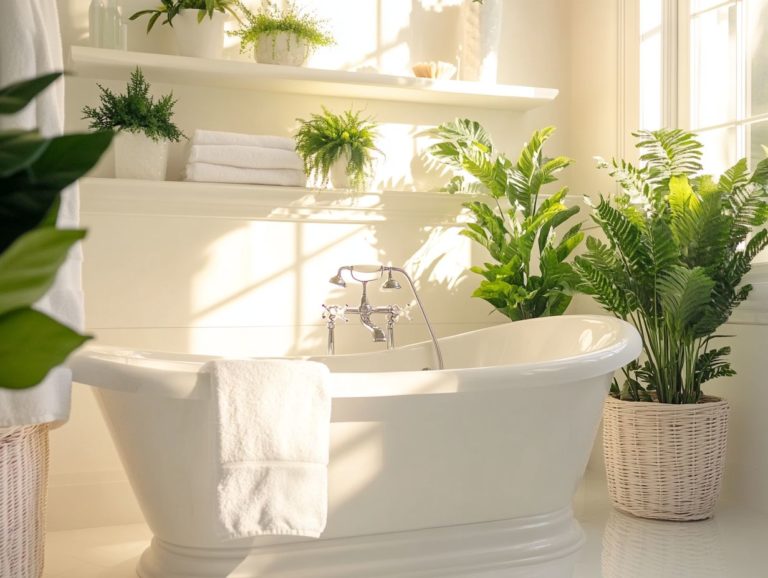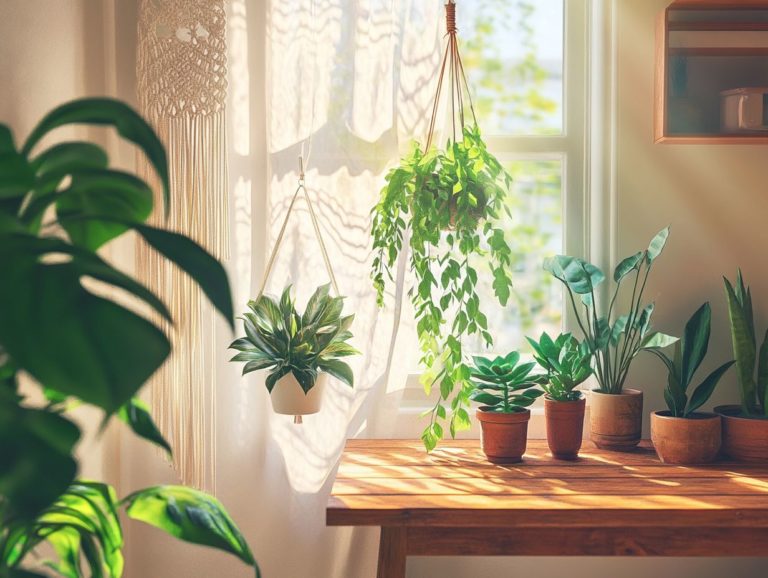Using Terrariums as Indoor Plant Decor
Terrariums transcend mere decoration; they are miniature ecosystems that invite the beauty of nature into your living space. Whether you re a seasoned plant lover or just dipping your toes into the green world, understanding terrariums and the various types available can unlock a realm of creativity and tranquility.
This article delves into the various benefits of terrariums, from their positive environmental impact to their captivating aesthetic. You ll receive guidance on selecting the right plants, crafting and maintaining your own terrarium, and troubleshooting any common issues that may arise. Discover inventive ways to integrate these living art pieces into your home decor.
Together, let’s explore the charm and functionality that terrariums can bring to your life!
Contents
Key Takeaways:
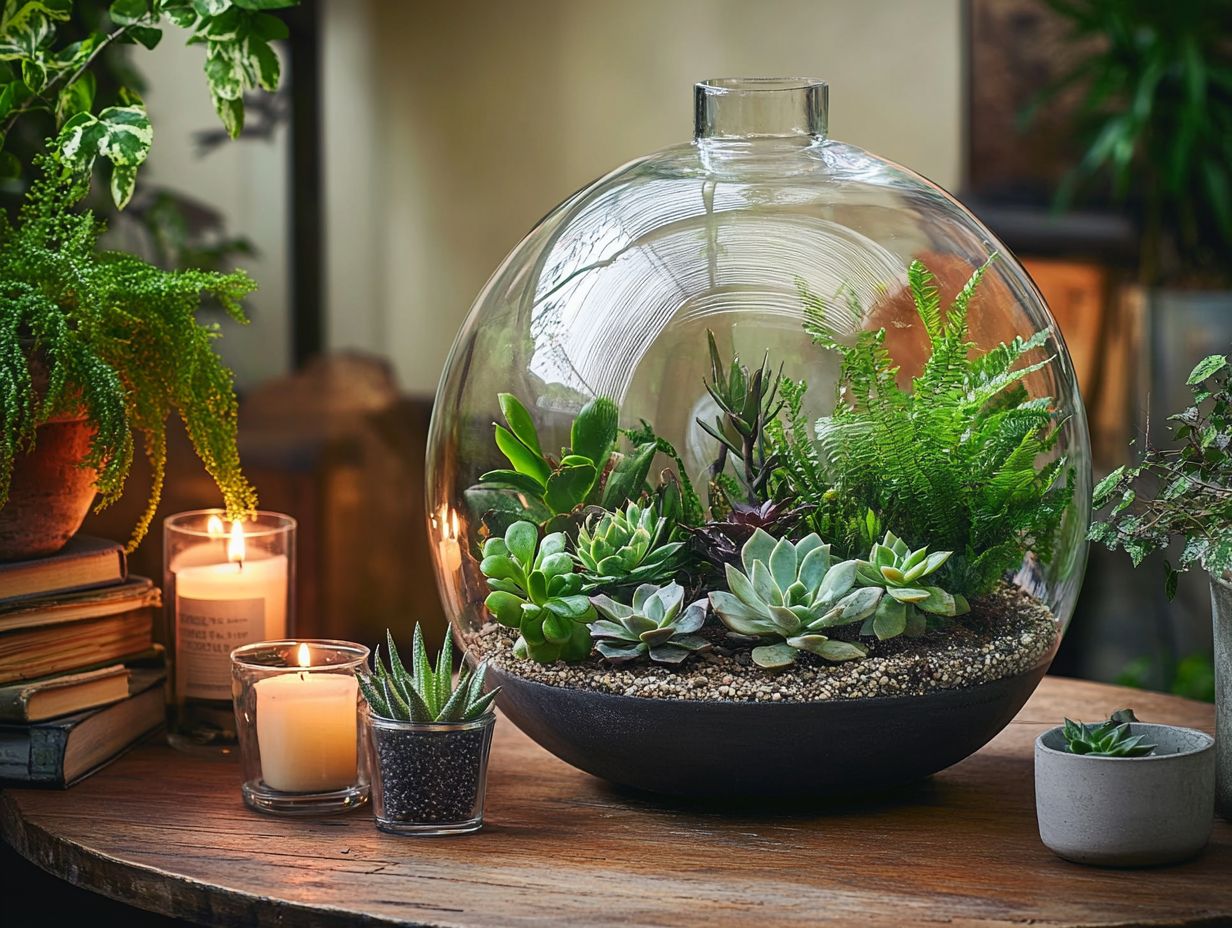
- Terrariums are self-contained, miniature gardens that can be used as stylish and low-maintenance indoor plant decor.
- Aside from adding a touch of green to your space, terrariums also have environmental benefits like improving air quality and reducing stress.
- When choosing plants for your terrarium, consider their light and humidity needs to ensure they thrive in their enclosed environment.
What is a Terrarium?
A terrarium presents an intriguing closed ecosystem (a system where plants and soil support each other in a sealed environment), enabling you to cultivate a delightful variety of plants within glass containers. This art form harks back to the Victorian era, when Nathaniel Bagshaw Ward masterfully popularized these miniature gardens.
These self-sustaining ecosystems flourish in their enclosed spaces, offering a stunning blend of creativity and environmental advantages while enhancing your indoor atmosphere and improving air quality.
Definition and Types
Terrariums come in various types, each serving unique purposes for your indoor d cor and plant care. Closed terrariums create a humid oasis, perfect for moisture-loving plants to thrive in their own mini-greenhouse environment.
On the other hand, open terrariums encourage better airflow, making them ideal for succulents and cacti that prefer drier conditions. Both types can be elegantly displayed in glass jars, offering a clear view of the fascinating ecosystems within.
Imagine a closed terrarium showcasing a lush, tropical landscape filled with ferns and moss. In contrast, picture an open terrarium with vibrant sandy soil housing resilient desert plants. These enchanting displays highlight the versatility and creativity you can express through your very own terrarium creations.
Benefits of Terrariums
Terrariums offer fantastic benefits that can brighten your indoor space and boost your well-being! They significantly enhance both environmental quality and personal well-being, making them an appealing choice for those seeking indoor greenery and a fulfilling therapeutic activity amidst the hustle and bustle of urban life.
Environmental and Aesthetic Advantages
The environmental and aesthetic benefits of terrariums are truly remarkable. They not only enhance indoor air quality but also add a decorative flair to your space with a variety of indoor plants.
These miniature ecosystems filter out pollutants and foster a calming atmosphere, helping you unwind after a hectic day. With the freedom to design, you can incorporate vibrant mosses, colorful succulents, or delicate ferns, all curated to elevate the aesthetic of any room.
Adding decorative elements like stones, figurines, or twinkling lights allows you to further personalize these green spaces, transforming them into striking visual statements. With options ranging from closed to open containers, you can select the perfect setup that matches your skills and preferences, creating a lush oasis that flourishes indoors.
Choosing the Right Plants for Your Terrarium

Choosing the right plants for your terrarium is essential for cultivating a flourishing ecosystem. Each species be it orchids, succulents, or ferns comes with its own unique requirements for light, humidity, and soil conditions.
Understanding these needs will set the foundation for a vibrant and healthy miniature garden.
Considerations for Different Environments
When selecting plants for your terrarium, it s essential to assess the environmental conditions like humidity and sunlight exposure that will influence their growth.
Different plants thrive in different conditions. Matching the species to the specific ecosystem you intend to cultivate is crucial. For example, tropical plants typically flourish in a humid atmosphere with indirect sunlight. In contrast, succulents thrive in drier environments bathed in more direct light.
Understand these requirements now to create an ideal habitat that mimics the plants’ native environments. Monitoring humidity levels is crucial; a hygrometer is a handy tool to measure humidity. Adjusting light exposure can be as straightforward as repositioning the terrarium or employing grow lights.
Paying attention to these environmental needs not only fosters healthy growth but also enhances the longevity of your plants.
Creating and Maintaining a Terrarium
Creating a vibrant terrarium is an exciting adventure! Here s how to do it:
- Begin by establishing a proper drainage layer to prevent waterlogging, which is vital for the health of your plants.
- Select a suitable potting medium that encourages healthy plant growth.
- Adhere to essential gardening tips that focus on moisture retention and overall plant vitality to ensure your terrarium thrives beautifully.
Step-by-Step Guide
To create a successful terrarium, follow this step-by-step guide, covering everything from selecting the right glass containers to choosing suitable plants and layering for optimal growth.
Starting with the right glass container is essential. It enhances the aesthetic appeal while ensuring proper air circulation and light penetration for the plants within. Go for a clear, transparent option, like a jar or a specially designed glass terrarium, to offer a captivating view into your miniature ecosystem.
Once you ve picked your container, consider the size and type of plants you wish to include, ensuring they fit harmoniously without overcrowding.
Incorporating layering materials such as gravel for drainage, activated charcoal to keep odors at bay, and potting soil is key to promoting healthy growth. Each layer serves a vital purpose in maintaining moisture and allowing roots to thrive, ultimately setting the stage for your flourishing green sanctuary.
Decorating with Terrariums
Incorporating terrariums into your decor offers a distinctive decorative flair, transforming your space with focal point arrangements that elevate indoor greenery while allowing for creative ideas.
These enchanting creations allow you to showcase ornamental elements, like delightful miniature garden gnomes, adding both charm and personality to your surroundings.
Ideas for Incorporating Terrariums into Your Space
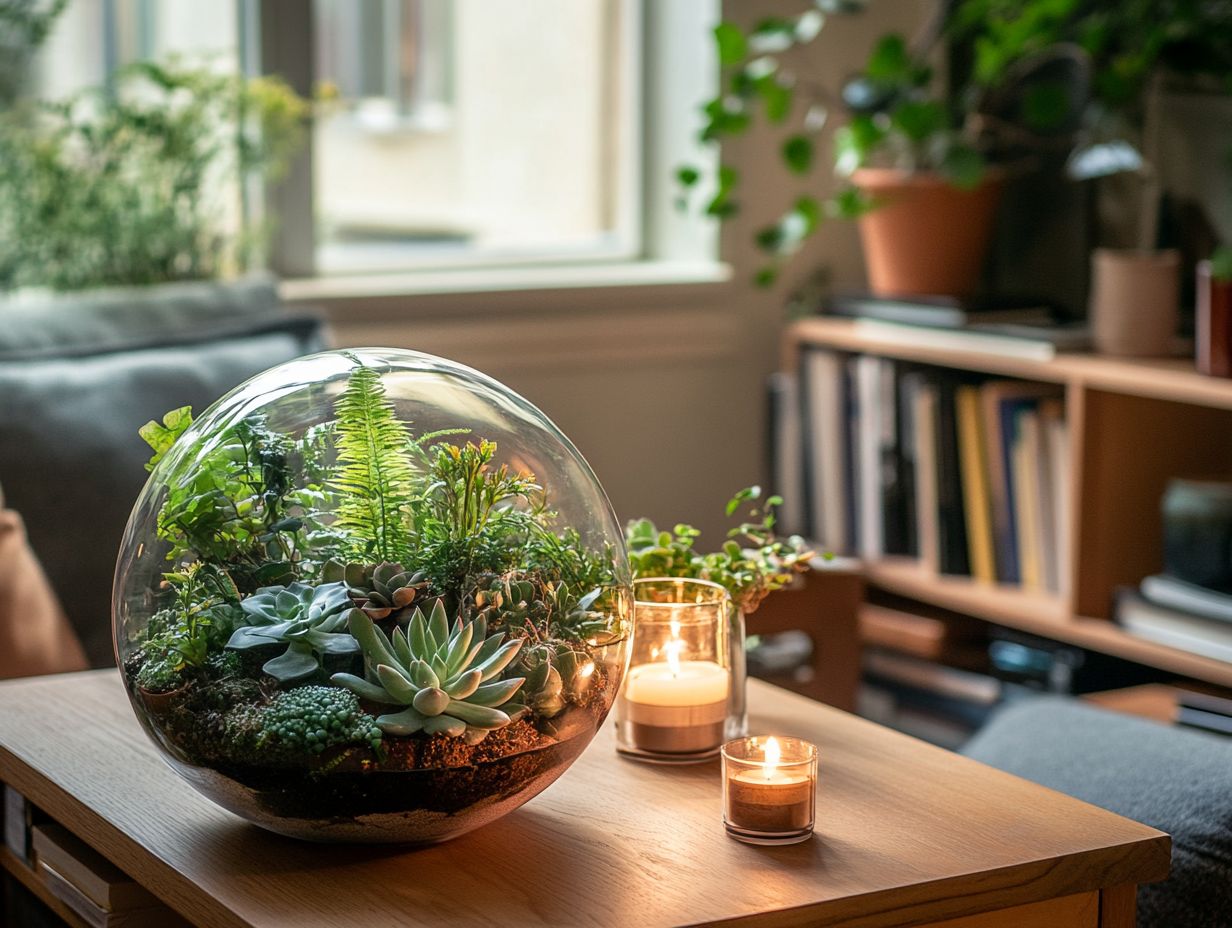
You have countless ways to incorporate terrariums into your space. From hanging terrarium specimens to elegant table centerpieces, each offers a unique style and a canvas for creativity.
These enchanting glass gardens can seamlessly adapt to various settings, whether it s a minimalist office, a cozy living room, or a sleek modern kitchen. Imagine placing a vibrant terrarium on a stylish shelf, softening the sharp lines of contemporary decor, or opting for a cluster of smaller ones as playful accents on your coffee table.
The allure of terrariums lies not just in their visual charm but in their ability to harmonize with a variety of themes, be it bohemian, industrial, or rustic. By experimenting with different plants, stones, and containers, you can craft a personalized arrangement that reflects your taste and infuses life and freshness into any indoor environment.
Troubleshooting Common Issues
Troubleshooting common issues in terrariums is essential for achieving successful plant care. By honing your skills in identifying and addressing challenges related to humidity, plant growth, and the overall health of the ecosystem, you can create a thriving environment for your plants.
Start your terrarium journey today and watch your indoor garden thrive!
Solutions for Common Problems
Humidity levels are crucial for your plants’ health and growth. If it s too dry, your leaves may start to wilt or turn brown.
On the other hand, too much humidity can lead to mold and mildew. Keep a close eye on moisture levels to maintain a healthy terrarium!
A hygrometer can help you keep track of humidity levels. If you find levels dipping too low, a gentle misting or placing a small dish of water inside can work wonders. Conversely, if humidity is running high, ensure proper ventilation by occasionally opening the terrarium or removing the lid for short bursts.
By monitoring these environmental factors, you can create the best conditions for your greenery to flourish beautifully.
Frequently Asked Questions
Can I use any type of plant in a terrarium for indoor decor?
Yes, as long as the plant can thrive in a closed, humid environment. Succulents, tropical plants, and orchids are popular choices for plant terrariums.
Do I need special tools to create a terrarium?
No, you can use everyday household items such as glass containers, nutrient-rich soil, and small gardening tools to create a terrarium.
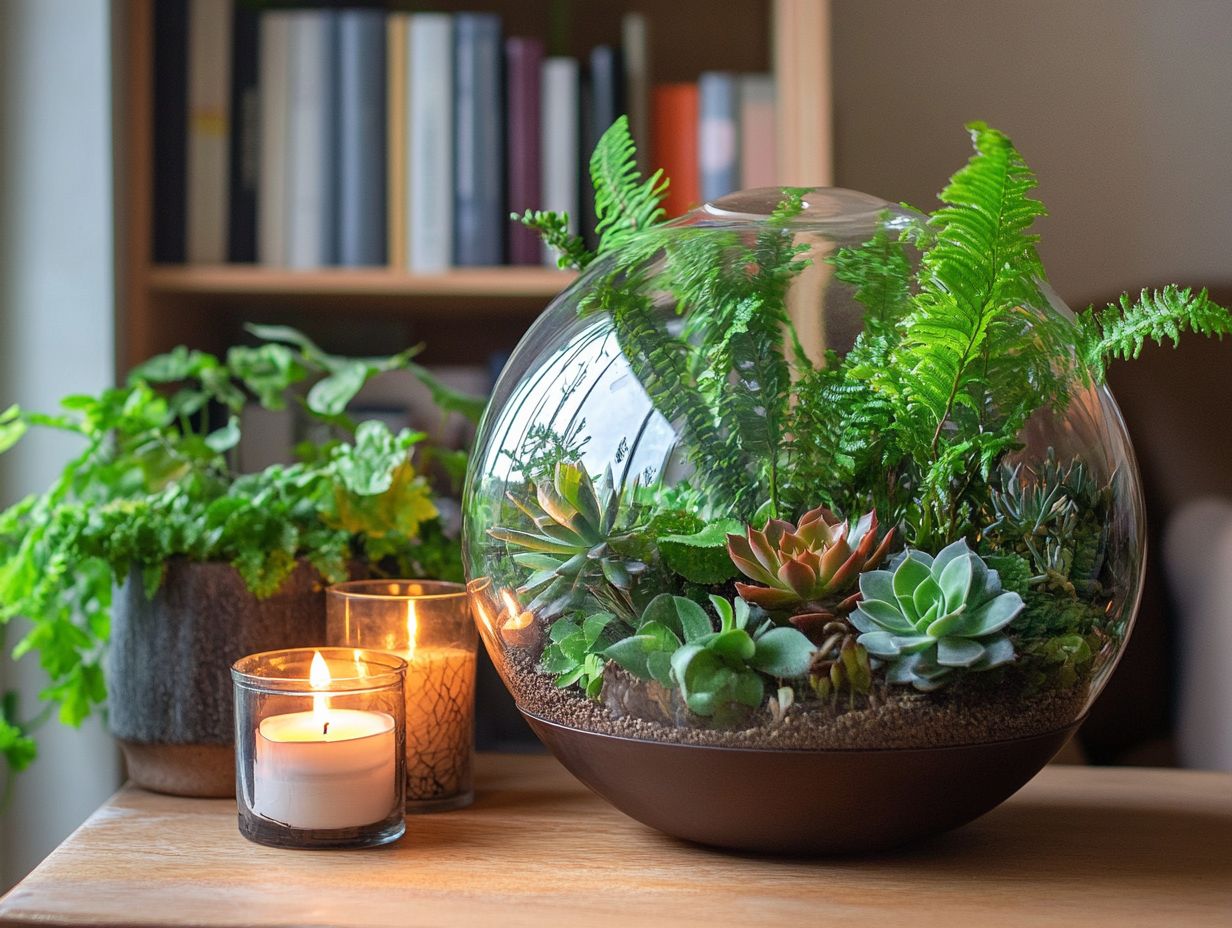
How often do I need to water a terrarium?
It depends on the type of plants you have chosen, their moisture retention needs, and the size of your terrarium. Generally, a terrarium should be watered every 1-2 weeks, especially during winter.
Can I place a terrarium in direct sunlight?
No, terrariums should be placed in indirect light to prevent overheating and burning of the plants, ensuring a healthy microclimate.
What is the ideal location for a terrarium?
Terrariums can be placed on any flat surface, but it is best to choose a spot with indirect light, consistent temperature, and good air circulation to create a self-sustaining closed ecosystem.
How do I maintain a terrarium?
Terrariums require minimal maintenance. Regularly check for any dead or dying plants and remove them. Water the terrarium as needed. Incorporating gardening tips and terrarium maintenance practices will help ensure plant growth. You may also need to trim or prune plants to maintain the desired shape and size.


